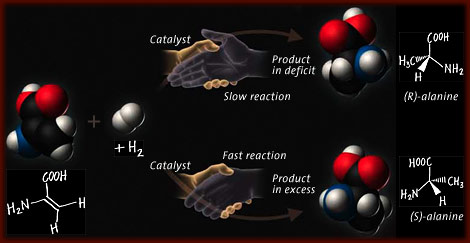How does a chiral molecule function?
| The Nobel Prize in Chemistry 2001 | |
||||||
|
|
|
|
The substances used as the starting point for these syntheses are in general not chiral. The trick is to make the product chiral. This is done using a chiral catalyst molecule. Suppose we compare this molecule with a left hand. A left hand will make a better match in a handshake with another left hand (one of the two emerging product forms) than with a right hand (the other form of the product). Thus a chiral catalyst can control production of the desired chiral product.
 |
||||
|
|||||||
Nobel Prizes and laureates
Six prizes were awarded for achievements that have conferred the greatest benefit to humankind. The 12 laureates' work and discoveries range from proteins' structures and machine learning to fighting for a world free of nuclear weapons.
See them all presented here.
